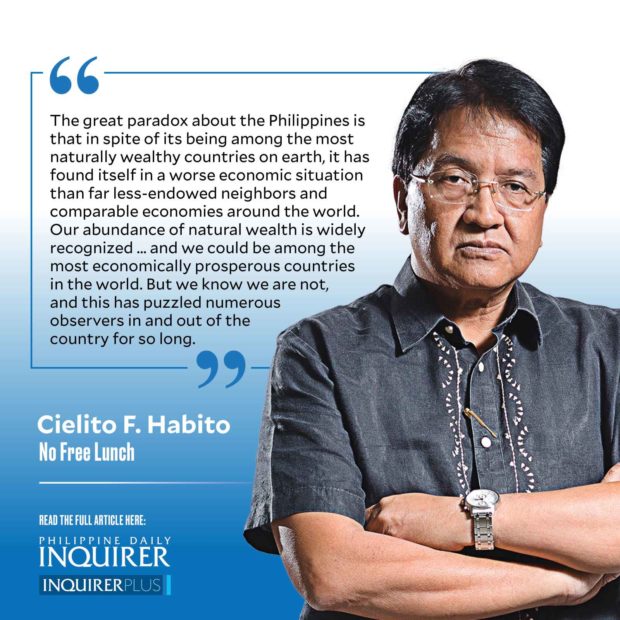Resource-rich but income-poor
The great paradox about the Philippines is that in spite of its being among the most naturally wealthy countries on earth, it has found itself in a worse economic situation than far less-endowed neighbors and comparable economies around the world. Our abundance of natural wealth is widely recognized. Our 300,000 square kilometers of land and inland waters host an extremely rich and diverse array of plant and animal life. With more than 36,000 kilometers of coastline and abundant inland waters, we have an extremely rich array of marine and freshwater resources known to be among the richest and most diverse in the world. We have more than 50,000 plant and animal species existing in the country, about two-thirds (65 percent) of which are unique to us—with more new species reportedly discovered every year than elsewhere in the world. We are one of the 17 megadiversity countries of the world that together account for 60-70 percent of global biodiversity, and are also known to be the fifth most minerally endowed country, globally. With all those natural riches, we could be among the most economically prosperous countries in the world.
But we know we are not, and this has puzzled numerous observers in and out of the country for so long. Cross-country comparisons on cost of living (worlddata.info) show the cost of living in the Philippines significantly exceeding that in Malaysia, Thailand, Indonesia, and Vietnam. But our average income (gross domestic product per capita) of $3,549 in 2021 was less than one-third that in Malaysia ($11,371), one-half of Thailand’s ($7,233), about 20 percent lower than Indonesia’s ($4,292), and slightly below Vietnam’s ($3,694). Right now, as our poor reel under the weight of high and escalating food prices, it’s a sad fact that food prices in this country are much higher than, and in many cases a multiple of, those in our Southeast Asian neighbors. And yet, we like to point out that many of their agricultural scientists actually studied here in Los Baños.
Article continues after this advertisementOur inflation in the past three years had in fact primarily traced to short supplies of basic farm and fishery products. The agriculture and fisheries sector also hosts the poorest of the Filipino poor, particularly in coconut farming and fishing communities. Meanwhile, our green (agriculture and forestry) and blue (aquatic and marine) economic assets have been beset by unsustainability and environmental degradation that threatens their capacity to sustain generations of Filipinos yet to come.
What has been our problem? It sums up in one word: productivity, especially in our agriculture sector. Simply defined, productivity measures the amount of output produced with a given amount of inputs and reflects production efficiency and improved technology. Production efficiency can be improved simply by changing farm practices. This could mean just changing the way work is organized on the farm, timing of planting and harvesting (to minimize vulnerability to bad weather, for example), growing more than one crop or sequencing alternate crops (i.e., intercropping or multiple cropping), and many more. Technological improvement comes out of research, usually on seed improvement (development of hybrids), soil improvement, pest management, developing more efficient machines, and so on.
I believe that too many people, especially policymakers in government, fail to distinguish production from productivity, and are content to maximize the former, regardless of the latter. Historical calls for food self-sufficiency appear to have inordinately focused on maximizing local production, neglecting the need to maximize productivity as well. In effect, the goal was to maximize local production at whatever cost, perpetuated by a policy that shut out foreign competition by banning or restricting imports. By removing the impetus to match the productivity of our neighbors, we slipped into a long-term complacency that led us to where we are today.
Article continues after this advertisementToo many people miss the point when they brand economists “import lovers” as they call for opening up. It’s not about loving imports. It’s about pushing ourselves to shape up with competition.
















